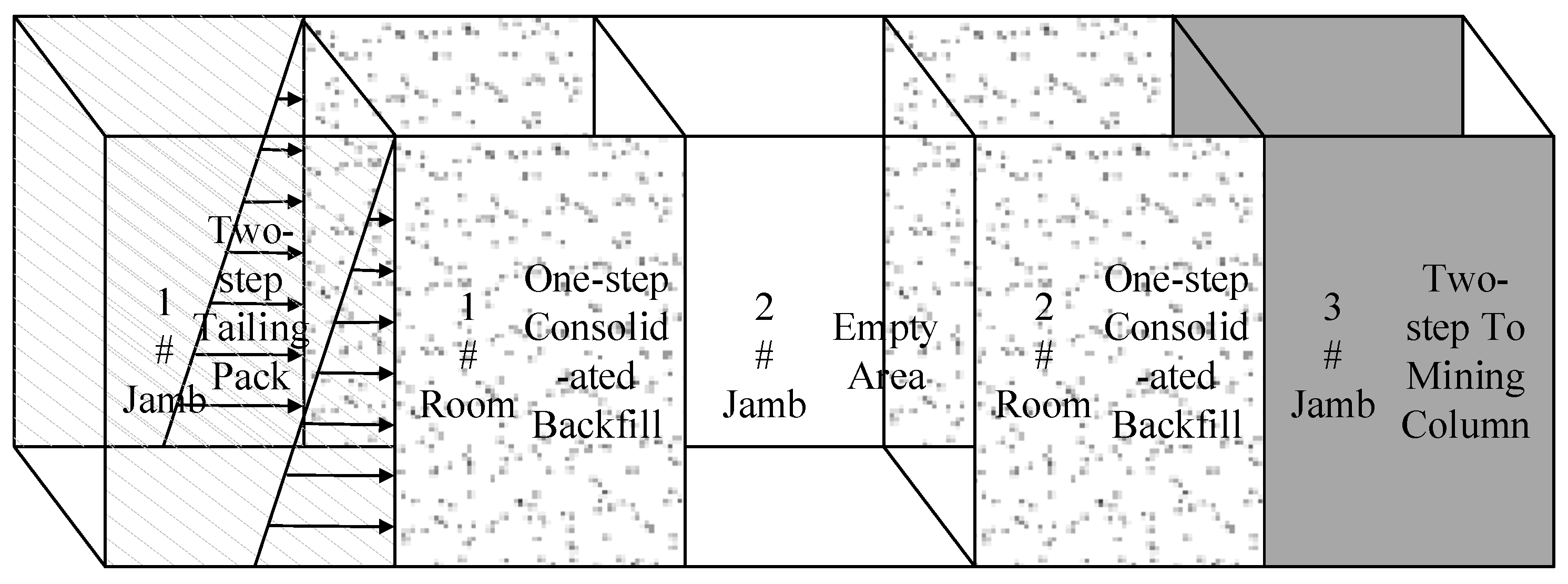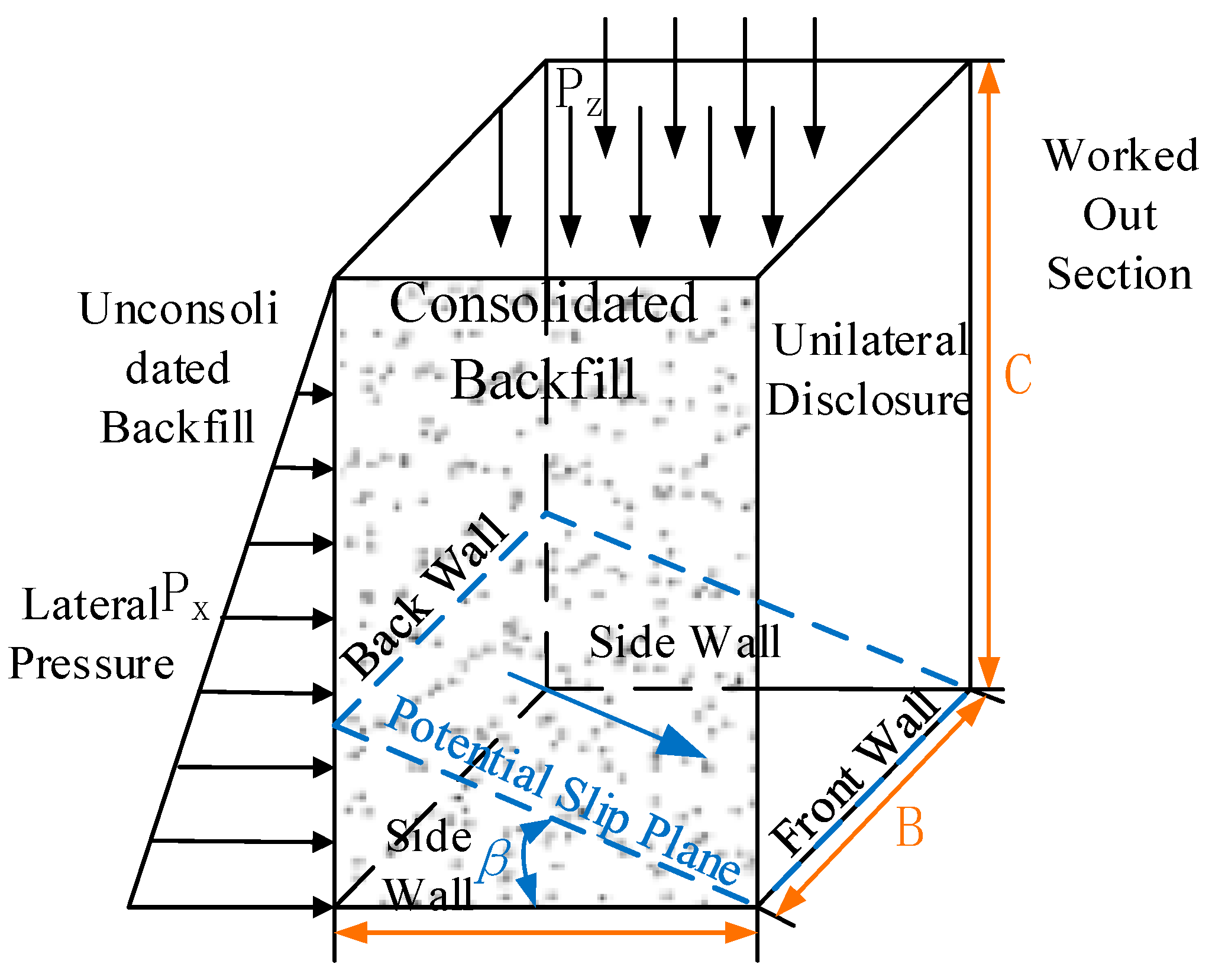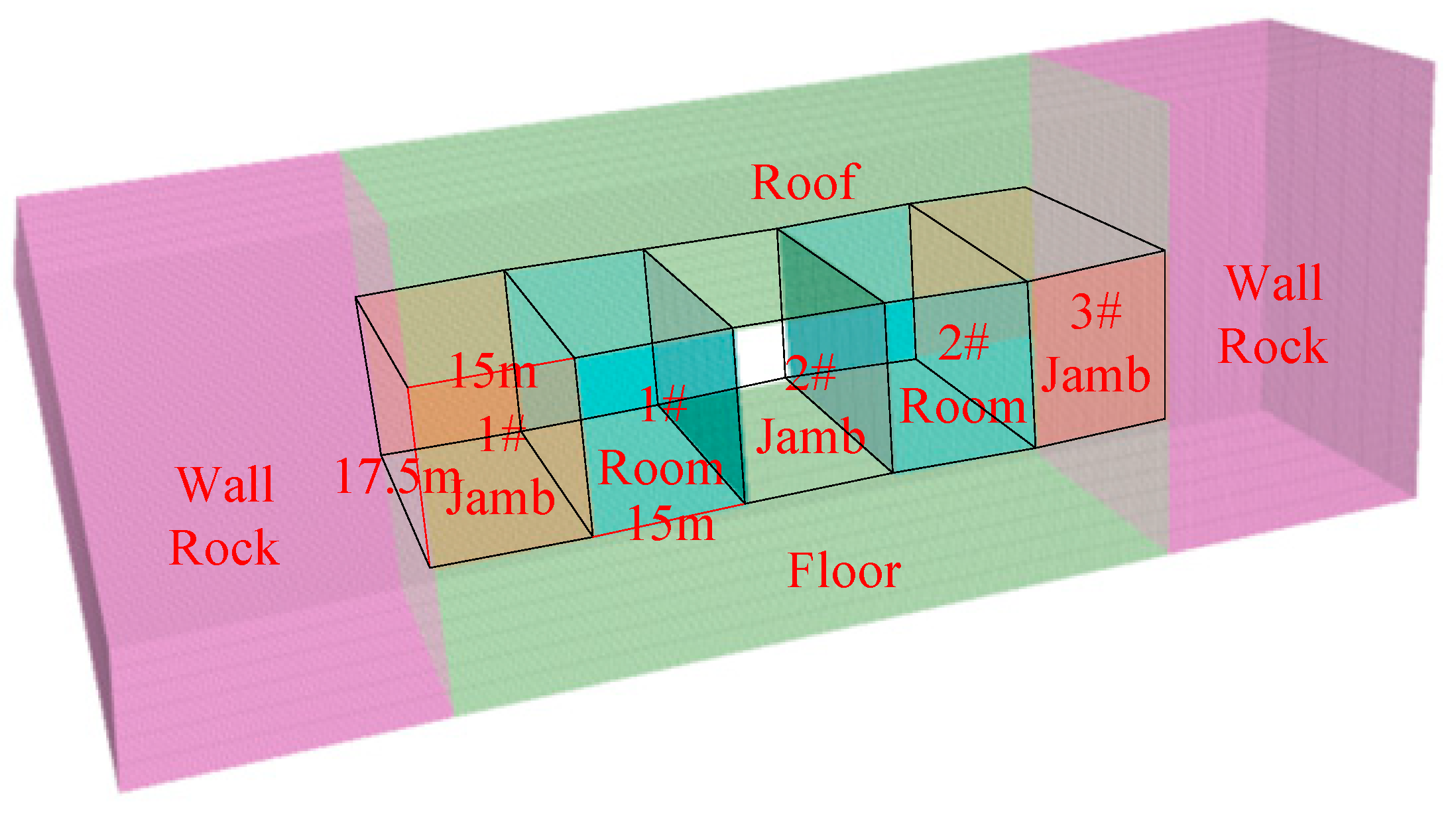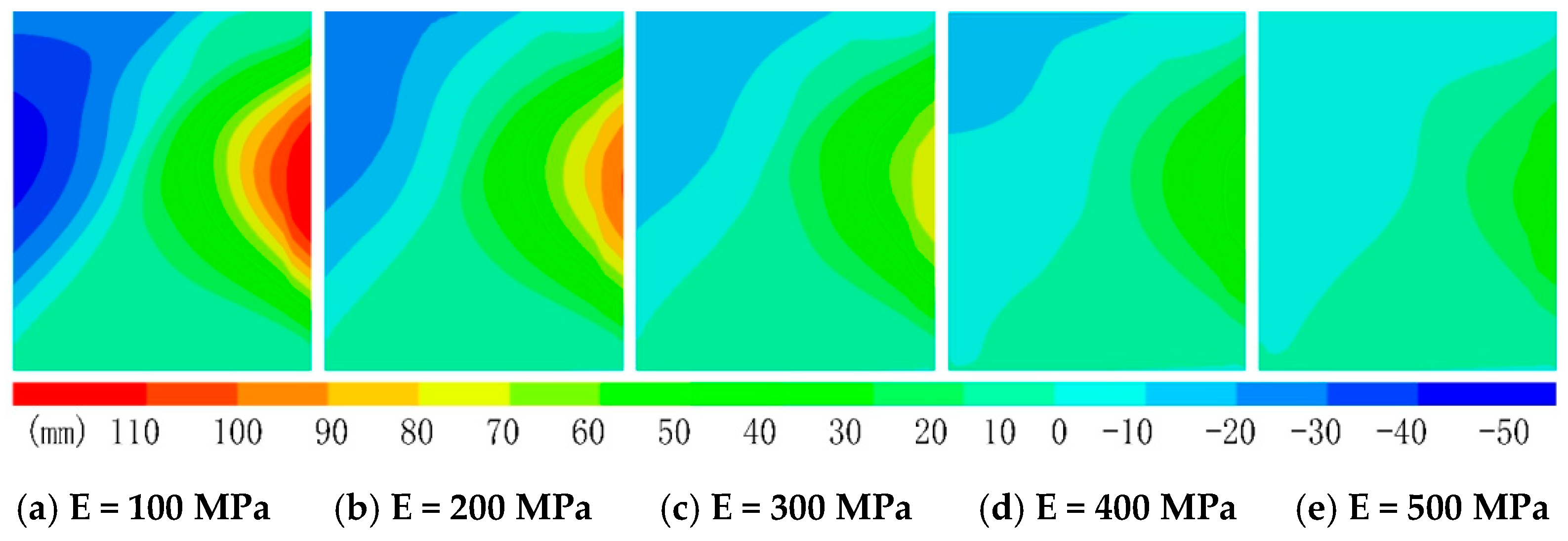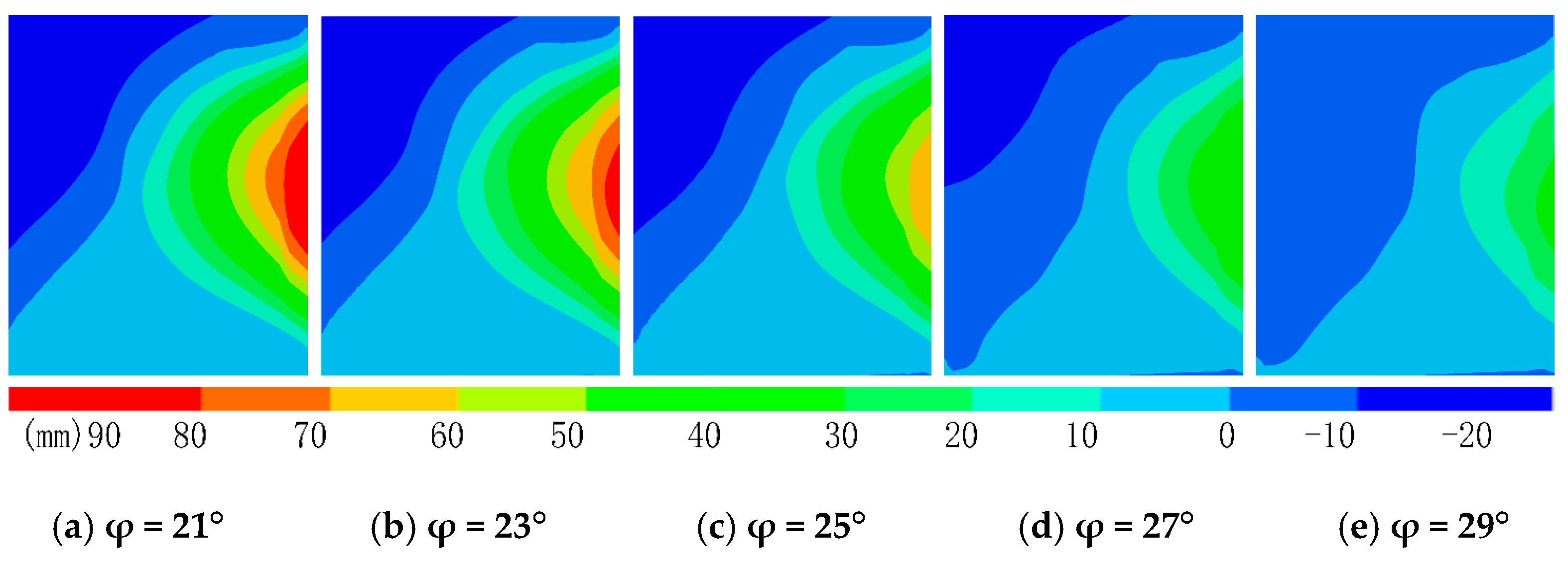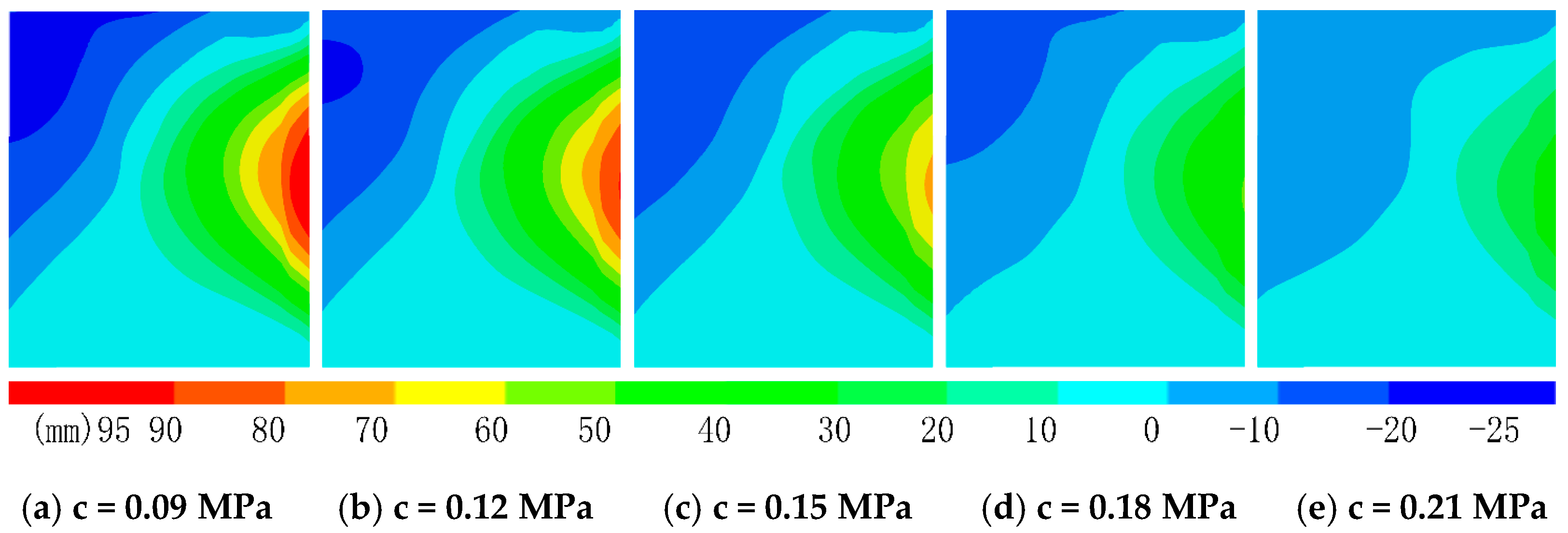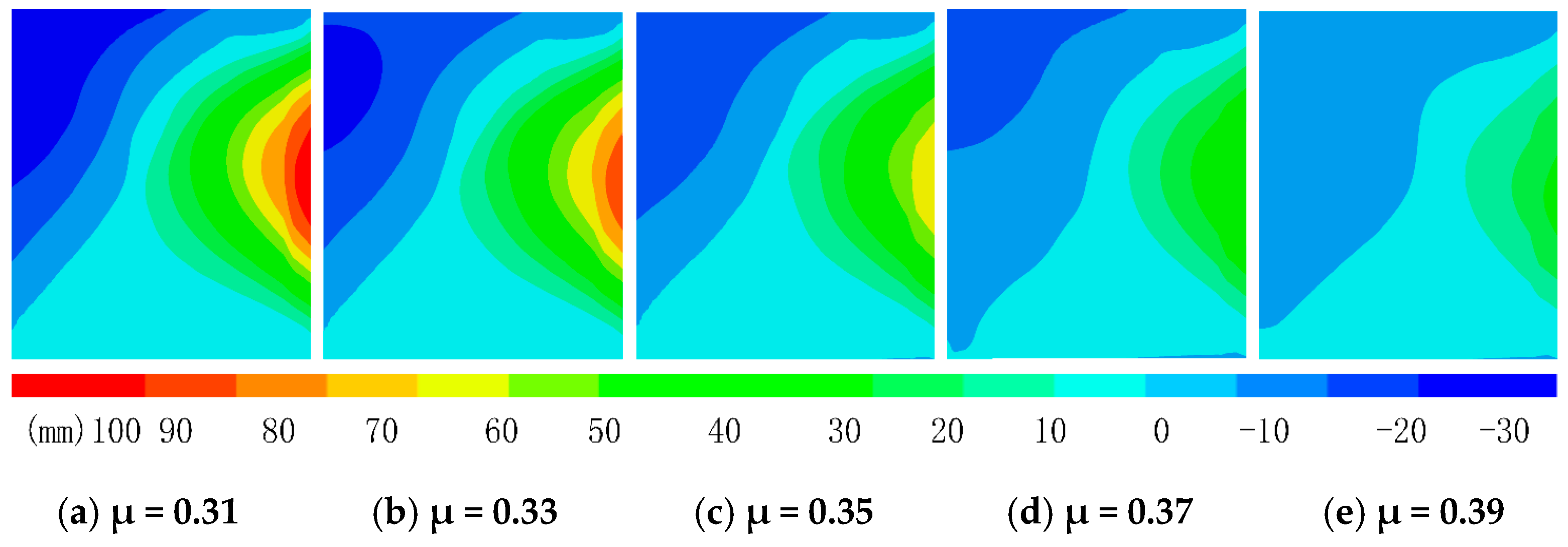1. Introduction
In the two-step sublevel filling method, the first step is to go back to the mining room for strong cemented filling, and the second step is to carry out non-cemented or weakly cemented filling after mining pillar [
1]. In actual two-step mining, the ore pillars of both sides of the strong cemented filling body are horizontally exposed and are subjected to the lateral pressure of the adjacent non-cemented or weakly cemented filling body [
2]. Because of the fluidity of the tailing filling body, it produces lateral pressure on the one-step cemented filling body, which makes it easy to cause the one-step cemented filling body to collapse to one side of the empty area. Therefore, ensuring the mechanical properties of the two-step non-cemented or weakly cemented filling is of great practical significance for the safe implementation of the subsequent two-step filling [
3].
Many scholars at home and abroad have studied the stability of filling stope by means of monitoring, tests, theories, and simulation [
4,
5,
6]. In the field of on-site monitoring, some scholars have studied the influence of surrounding rock stress change characteristics and mining cumulative superimposed disturbance effects on the stability of filling stope through on-site monitoring and similar simulation, and have studied the dynamic stability law of filling body deformation [
7,
8]. In laboratory tests, some scholars have studied the influence of factors such as the water–cement ratio, adjacent curing period, or backfill–boundary medium combination on the mechanical properties of backfilling. For theoretical analysis, some scholars have studied the exposure stability of cemented filling bodies with different stope parameters and mining sequences based on the analytical model of two-dimensional plane strain theory, the classical analytical method, and the limit equilibrium method. Combined with the mechanical relationship among strong cemented filling bodies, weak cemented filling bodies, and the surrounding rock, the stability of filling stope under unilateral pressure was studied [
9,
10]. For numerical simulations, some scholars have studied the influence of the delamination effect and lateral coefficient on the slip surface and analyzed the influence characteristics of backfill side stability under mining disturbance and lateral pressure [
11,
12].
The viewpoint of passive support for cemented backfill mainly focuses on the self-supporting effect of cemented backfill. The backfill plays a passive support role under its own weight and lateral pressure, that is, analyzing the influence of the exposed area and exposure time of the backfill on the stability of the mining site. This design approach is suitable for mining environments with large exposed areas and long support times. The active support viewpoint of cemented backfill focuses more on the ability of the backfill to withstand support pressure during pillar mining. The filling material reduces the deformation of the surrounding rock by supporting the distribution of compressive stress on the roof, thereby improving the overall stability of the mining area. This method is particularly suitable for deep mining scenarios that require effective sharing of roof pressure [
13,
14,
15]. When analyzing the mechanical stability of the cemented filling body in the filling stope, the traditional analysis model does not take into account the stress of the filling body exposed by the front wall and the back wall. In order to better evaluate the stability of the filling body and provide advice for mining, it is necessary to study the influence of lateral pressure from two-step sudden filling on the stability of a one-step cemented filling body with front wall exposure and back wall pressure. The influence of the mechanical parameters of a loose two-step weakly cemented or non-cemented filling body on the stability of a one-step filling body is considered. This provides a scientific basis for the stability study and strength design of unilateral exposed filling bodies [
16,
17].
Domestic and foreign scholars’ research on cemented fill mainly focuses on the mechanical properties of the fill and its interaction with the surrounding rock mass. In recent years, many studies have focused on the compressive strength, rheological properties, and filling effect of filling materials on goaf during mining processes [
18,
19,
20]. During the process of pillar mining, strong cemented backfill will be subjected to lateral pressure from adjacent weak cemented backfill, thereby affecting its stability [
21,
22,
23]. However, relevant research both domestically and internationally is mostly based on the actual situation of Chinese mines [
24]. Although some research progress has been made in this field, its influence in the international academic community still needs to be improved [
25]. Most studies have not fully considered the international mining system, especially the relevant research results in Europe and the United States, which to some extent limits the global knowledge dissemination of these studies. Internationally, especially in Europe and the United States, many studies are also exploring the stability of filling materials, especially the mechanical behavior of filling materials under complex geological conditions [
26,
27,
28]. For example, some mining research centers in Europe have explored the influence of different types of filling materials on the stability of mine filling bodies and conducted extensive experimental and theoretical analyses on the deformation behavior of different filling bodies under different pressure conditions using advanced numerical simulation techniques [
29,
30]. These studies indicate that the stability of the filling material is closely related not only to the mechanical properties of the filling material, but also to factors such as the design of the mining system and the geological structure of the mining area [
31,
32,
33]. Therefore, considering the achievements of different research centers around the world, researchers should broaden their horizons and draw on the research progress of other regions, especially the experience of Europe and the United States, in the study of filling stability [
34,
35,
36].
Based on this, taking the two-step filling stope of a mine in Shandong Province as the research object, in order to deeply analyze the influence of the mechanical parameters of a two-step non-cemented or weakly cemented filling body on the stress and displacement of a one-step strongly cemented filling body exposed to the front wall and the back wall under pressure, the lateral pressure of the two-step filling body on the one-step cemented filling body is analyzed, and a numerical simulation analysis is carried out by keeping other parameters unchanged and changing a single variable [
37,
38]. The aim is to provide theoretical guidance for the reasonable determination of the strength of the filling body under unilateral exposure [
39,
40]. This study advances current research by developing a three-dimensional mechanical model that integrates the lateral pressure effect of weakly cemented backfill on single-sided exposed cemented backfill. Unlike previous work, our model explicitly considers the interaction between front wall exposure and rear wall compression, providing new insights into displacement patterns and stability mechanisms under different mechanical properties [
41].
3. Lateral Pressure Action and Lateral Pressure Calculation
3.1. Lateral Pressure Action
In two-step pillar mining, the stope support comes from the one-step cemented filling body. The unilateral cemented filling body is subjected to the lateral pressure of the adjacent non-cemented filling body, which produces horizontal thrust and affects the stability of the stope. In order to evaluate the stability, the lateral pressure of the adjacent filling body and the mechanical properties of the two-step sudden filling body should be considered. When the cemented filling body is subjected to the lateral pressure of the two-step non-cemented tailings filling body, tailings can be regarded as bulk medium. Because of the fluidity of bulk media, tailings tend to slide and collapse under the action of their own gravity, so they will exert active pressure on the cemented backfill. Through the three-dimensional mechanical model of the cemented filling body exposed unilaterally on the front wall and the compression body on the posterior wall side, the stress state of the unit body on the contact surface of the two bodies is analyzed (as shown in
Figure 2, P
x represents lateral pressure, P
z represents pressure, A represents pillar width, and B represents pillar length). The complex interaction between cemented filling and non-cemented filling is also considered, so as to provide a more comprehensive and accurate stability evaluation. It is helpful to deepen the understanding of the behavior of the filling body in the process of mining, which provides a scientific basis for safety design and construction in practical engineering.
3.2. Lateral Pressure Calculation
The formula for calculating the self-weight of the wedge-shaped sliding body of a cemented filling body is as follows [
42]:
Among the variables, is the bulk density of the cemented filling body, kN/m3; A is the pillar width of the filling body, m; B is the pillar length of the filling body, m; C is the pillar height of the filling body, M; and is the angle between the shear force direction and the horizontal direction of the contact surface.
Considering the weight W of the wedge-shaped sliding body of the cemented filling body and the pressure P
z of the overlying rock, the resultant force is [
43]
Among the variables, the overlying rock pressure of Pz, the cemented filling body, is KPa.
According to the natural equilibrium arch theory, the rock pressure on the upper part of the filling body is as follows:
Among the variables, is the average bulk density of the upper rock, and is measured in kN/m3; is the Platts coefficient of the surrounding rock.
The formula for calculating the lateral pressure between the tailings and cemented backfill is as follows:
Among the variables, is the bulk density of non-cemented filling, and is measured in kN/m3; K is the active lateral pressure coefficient.
Taking into account the contact area (BC) of lateral pressure, the resultant force of lateral pressure caused by tailings to the cemented filling chamber is [
44]
Among the variables, F represents the resultant force due to the overlying rock pressure acting on the filling body.
5. Study on the Influence of the Mechanical Properties of a Two-Step Filling Body on the Displacement of an Exposed Compression Cemented Filling Body
5.1. Effect of Elastic Modulus on Displacement Distribution
Under the condition of changing the elastic modulus of the two-step weakly cemented filling body and keeping other parameters constant (scheme 1), the influence of the change in elastic modulus parameters on the stability of the front wall exposed–posterior compression cemented filling body was analyzed by numerical simulation.
Figure 4 shows the horizontal displacement distribution of the exposed surface of the one-step cemented filling body in the case of different elastic modulus parameters of the weak cemented filling body. By observing these five pictures, it can be found that in the case of different elastic moduli of the two-step weak cemented filling body, the analysis of the horizontal displacement of the one-step strong cemented filling body is basically similar in the stress environment exposed unilaterally, and shows a large amount of deformation on the exposed side. The maximum displacement reveals the middle position of the height of the side filling body, revealing that the horizontal displacement of the side shows a symmetrical distribution in the height direction. With the increase in the elastic modulus parameters of the two-step weakly cemented filling body, the horizontal displacement of the one-step cemented filling body decreases, and its stability increases. When the elastic modulus of the two-step weakly cemented filling body increases from 100 MPa to 500 MPa, the maximum horizontal displacement of the one-step cemented filling body exposed on one side decreases from 116 mm to 32 mm, a decrease of approximately 72%. When the elastic modulus parameters of the two-step filling body are 200 MPa, 300 MPa, and 400 MPa, the maximum horizontal displacements of the one-step filling body are 91 mm, 69 mm, and 47 mm, respectively. Studies have shown that increasing the elastic modulus and cohesion of weakly cemented filling bodies can significantly reduce the displacement of unilaterally exposed cement filling bodies. This discovery provides a basis for the strength design of filling bodies in mining engineering, especially in the context of the demand for reducing ore pillars and improving mining efficiency. The research results provide data support for solving the slip risk of unilaterally exposed filling bodies or reducing material costs.
Based on the comprehensive analysis of the numerical simulation results, it can be found that the change in the elastic modulus of the two-step weakly cemented filling body has a significant effect on the displacement distribution of the one-step cemented filling body, in which the front wall is exposed and the back wall is pressed. The increase in elastic modulus indicates that the stiffness characteristics of non-cemented backfill are enhanced, and the trend of fluidity and collapse is weakened, so its ability to resist deformation and failure is also enhanced. Therefore, we come to the conclusion that the change in the elastic modulus of weakly cemented backfill has a significant influence on the displacement distribution of cemented backfill, which is a negative correlation.
5.2. The Influence of the Internal Friction Angle on Displacement Distribution
Under the condition of changing the internal friction angle of the two-step weakly cemented filling body and keeping other parameters constant (scheme 2), the influence of the change in the internal friction angle parameters on the stability of the front wall exposed–posterior compression cemented filling body is analyzed by numerical simulation.
Figure 5 shows the horizontal displacement distribution of the weakly cemented filling body exposed unilaterally at different internal friction angles. It can be concluded from the figure that the closer the feature to the exposed surface, the larger the horizontal displacement of the cemented filling body is, and the maximum horizontal displacement is approximately at 1/2 of the height of the cemented filling body; with the increase in the angle of internal friction, the maximum horizontal displacement of the exposed surface of the cemented filling body tends to decrease, and the horizontal displacement of the cemented filling body gradually approaches the safe range. At the same height, the horizontal displacement of the one-step cemented filling body exposed on one side decreases with the increase in the internal friction angle of the two-step weak cemented filling body. When the internal friction angle of the two-step weakly cemented filling body increases from 21° to 23°, 25°, 27°, and 29°, the maximum horizontal displacement of the exposed surface of the one-step cemented filling body is reduced from 95 mm to 86 mm, 69 mm, 48 mm, and 33 mm, respectively, compared with 21°. The reduction is 9%, 27%, 50%, and 65%, respectively.
Based on the above numerical simulation results, it can be found that the change in friction angle of the two-step weakly cemented filling has an obvious influence on the displacement distribution of the one-step cemented filling exposed unilaterally, showing a negative correlation.
5.3. Influence of Cohesion on Displacement Distribution
Under the condition of changing the cohesion of the two-step weakly cemented filling body and keeping other parameters constant (scheme 3), the influence of the change in cohesion parameters on the stability of the front wall exposed–posterior compression cemented filling body was analyzed by numerical simulation.
It can be seen from the horizontal displacement of the cemented filling body under different cohesion amounts (
Figure 6) that under the same cohesion parameter, the horizontal displacement increases slowly with the increase in height, and reaches the maximum horizontal displacement near the middle height of the filling body. Then, it gradually decreases with the increase in height. At the same height, through horizontal comparison, it can be found that with the increase in the cohesion parameters of the two-step weakly cemented filling body, the horizontal displacement of the one-step cemented filling body exposed unilaterally decreases gradually. When the cohesion of the two-step weak cemented filling increases from 0.09 MPa to 0.12 MPa, 0.15 MPa, 0.18 MPa, and 0.21 MPa, the maximum horizontal displacement of the exposed surface of the one-step cemented filling decreases from 96 mm to 87 mm, 69 mm, 48 mm, and 33 mm, respectively. The horizontal displacement of 0.12 MPa cohesion is reduced by 66% compared with 0.09 MPa cohesion.
Based on the comprehensive analysis of
Figure 6, it can be concluded that the cohesion of the two-step cemented filling body has an obvious influence on the horizontal displacement of the one-step cemented filling body in which the front wall is exposed and the posterior wall is pressed. This is because the cohesion of the two-step weakly cemented filling directly affects the bonding force between the particles of the filling body, and with the increase in the cohesion, the bonding strength between the particles of the two-step weakly cemented filling increases; thus, the lateral pressure of the one-step cemented filling decreases. The greater the cohesion of the two-step weakly cemented filling is, the smaller the trend of fluidity and collapse is, and the smaller the lateral pressure of the one-step cemented filling body is, the smaller the horizontal displacement of the one-step cemented filling body is.
5.4. Influence of Poisson’s Ratio on Displacement Distribution
Under the condition of changing the Poisson’s ratio of the two-step weakly cemented filling body and keeping other parameters constant (scheme 4), the influence of the change in Poisson’s ratio parameters on the stability of the front wall exposed–posterior compression cemented filling body was analyzed by numerical simulation.
It can be seen from
Figure 7 that in the two-step Poisson’s ratio parameter of the weakly cemented filling body, the influence of the one-step cemented filling body on the front wall exposure and the posterior wall compression is basically consistent with the influence of parameters such as cohesion and so on. The maximum displacement is located in the middle of the exposed surface. When the cohesion of the two-step weakly cemented filling increases from 0.31 to 0.33, 0.35, 0.37, and 0.39, the maximum horizontal displacement of the exposed surface of the one-step cemented filling decreases from 100 mm to 88 mm, 69 mm, 48 mm, and 32 mm, respectively. Relative to 0.09 MPa cohesion, the reduction was 12%, 31%, 52%, and 68%, respectively.
To sum up, increasing the Poisson’s ratio of the two-step weakly cemented filling body is also equivalent to increasing the self-stabilizing ability of the two-step weakly cemented filling body, which can reduce the lateral pressure on the one-step cemented filling body, reduce its influence on the one-step cemented filling body, and improve the stability of the stope.
6. Conclusions
Combined with the actual occurrence conditions of a scope filling body, the lateral pressure effect of a one-step cemented filling body caused by the trend of tailing collapse is analyzed, and a three-dimensional mechanical model of a two-step weakly cemented filling body considering the mechanical properties of a two-step weakly cemented filling body is constructed. In this paper, the influence of the different mechanical properties of a two-step weakly cemented filling body on the horizontal displacement of a cemented filling body exposed by the front wall and compressed back wall is studied, and the following main conclusions are drawn:
(1) In the two-step pillar stoping, the lateral pressure of the one-step cemented filling body is affected by the lateral pressure of the adjacent two-step weakly cemented filling body, which affects the stope stability. Its stability is affected by the mechanical properties of the weakly cemented filling body, the self-weight of the contact area cemented filling body, and the overlying rock pressure. Improving the mechanical properties of the two-step weakly cemented filling body can reduce the trend of tailing collapse and reduce the active pressure exerted by the cemented filling body.
(2) With the increase in cohesive force, the horizontal displacement moderately decreases, and the maximum horizontal displacement of the cemented filler decreases with the increase in the cohesive degree. The horizontal displacement of the cemented filling body with different mechanical properties (elastic modulus, internal friction angle, cohesion, and Poisson’s ratio) of the two-step weakly cemented filling body is similar, and the mechanical parameters are negatively correlated with the horizontal displacement. The mechanical parameters of the weakly cemented filling body are all negatively correlated with the horizontal displacement. The mechanical parameters of the weakly cemented filling body are raised, and the horizontal displacement of the one-step filling body decreases according to the relative influence. The order of importance to stability is the elastic modulus, Poisson’s ratio, cohesion, and internal friction angle. In the vertical direction, the maximum horizontal displacement is mainly located in the middle area of the filling body.
(3) Enhancing the mechanical properties of weakly cemented fillings, such as increasing the elastic modulus (optimal range: 300–400 MPa) or internal friction angle (>27°), can significantly reduce horizontal displacement and improve stope stability. These optimizations mitigate collapse risks and contribute to safer mining operations. The findings suggest that adopting stronger filling materials allows one to reduce the arm pillar thickness and increase ore recovery rates by up to 15%, thereby improving both safety and economic efficiency. These results are most applicable to deep mines utilizing sublevel filling methods with stopes exposed to significant lateral pressure.
In this study, we demonstrated that the mechanical properties of weakly cemented backfill materials significantly affect the stability of cemented fill under unilateral exposure. Improving the mechanical strength of two-step weakly cemented filling can not only enhance the stability of one-step cemented filling when exposed on one side, but also reduce the risk of collapse in complex mining environments. These findings provide practical guidance for designing safer filling methods in segmented mining operations, especially in mines with poor geological conditions. Improving the mechanical properties of two-step weakly cemented filling can significantly reduce tailing collapse, thereby minimizing the harm to personnel and equipment. These improvements can also reduce the required pillar thickness, potentially improving ore recovery and overall mining efficiency.
Building upon the findings of this study, future research could explore the following area: Dynamic stability under real-time mining conditions. While this study focuses on the static analysis of cemented backfill stability, real-time mining introduces dynamic factors such as vibrations, gradual subsidence, and operational disturbances. Future studies could integrate dynamic simulations to assess the long-term performance and adaptability of cemented backfill structures.
